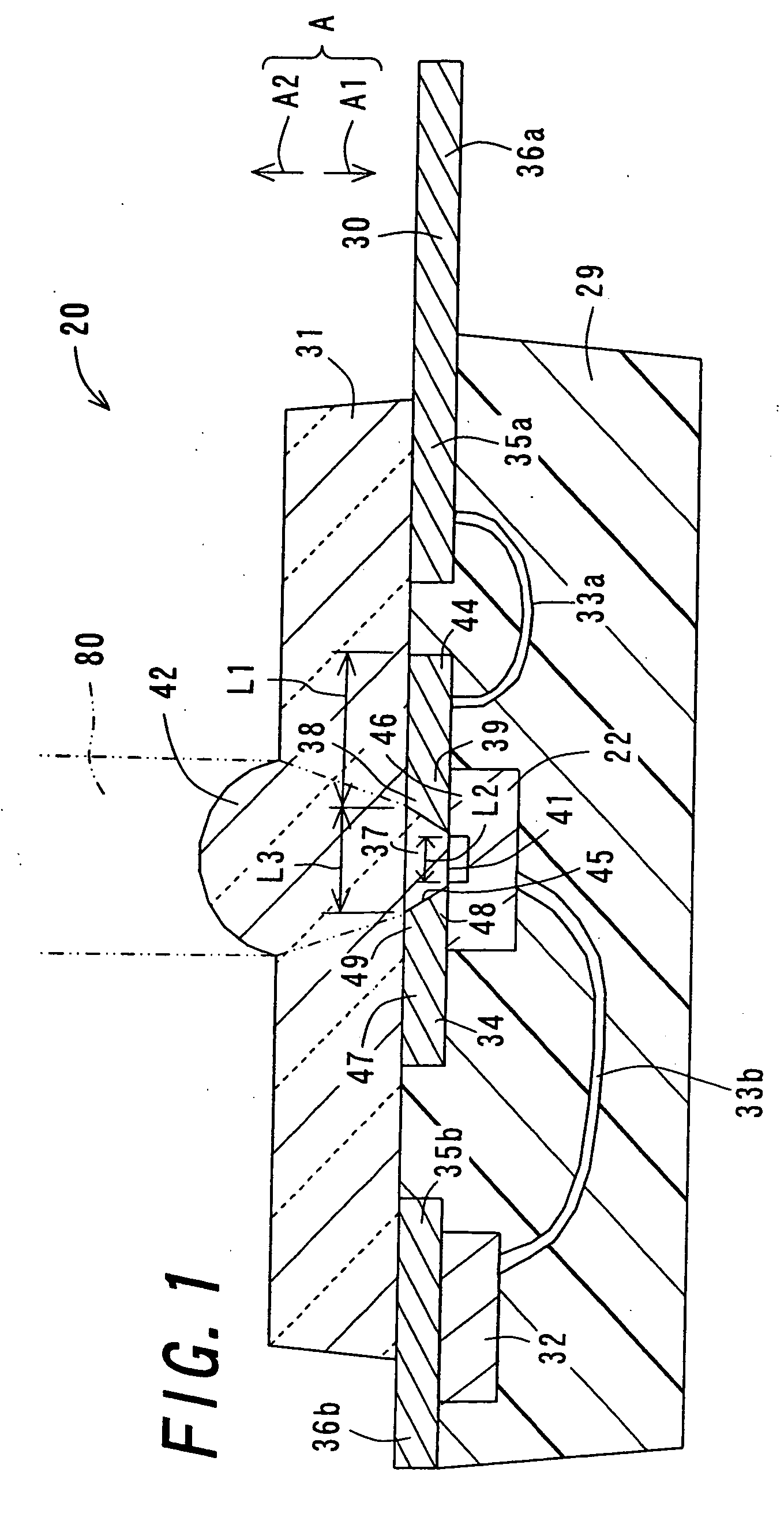Optical element sealing structure, optical coupler, and optical element sealing method
- Summary
- Abstract
- Description
- Claims
- Application Information
AI Technical Summary
Benefits of technology
Problems solved by technology
Method used
Image
Examples
first embodiment
[0097]FIG. 1 is a cross sectional view of a sealing structure 20 in the invention, and FIG. 2 is a cross sectional view of an optical coupler 21 including the sealing structure 20. For optical communications, the optical coupler 21 establishes a connection between an optical element 22 and an optical fiber 23 to be ready for optical transmission, i.e., so-called optical coupling apparatus. The optical element 22 is a semiconductor with the optical function, and for example, is a light-emitting element such as a light emitting diode (LED, Light Emitting Diode), and a light-receiving element such as a photo diode (PD, Photo Diode).
[0098] The optical fiber 23 is a cable formed to be flexible and long in length. The optical fiber 23 serves as an optical transfer medium that transfers light from one end portion to the other end portion. That is, light coming from one end portion of the optical fiber 23 passes through the optical fiber 23, and exits from the other end portion of the optic...
fifth embodiment
[0188] The sealing structure 420 of the fifth embodiment can be formed by molding. In this case, as to the lead frame 30 to be attached, in the sealing body molding mold 60, a first mold 61 serving as the side in the other thickness direction A2 forms an internal space between the lead frame 30 and a second mold. In this state, by filling a sealing molding resin into the internal space of the mold, the sealing body 29 is formed. At this time, the first mold portion 61 abuts on the optical element mounting section 34 of the lead frame 30, and the distance from an outer peripheral portion of the abutting portion of the mold portion 61 to the light transmitting section 38 is set to the above-described separation distance L1. This prevents the sealing molding resin from finding its way to the light transmitting section 38. Further, because the optical element 22 never abuts on the first mold portion 61, the optical element 22 can be protected from any possible damage. When the sealing m...
sixth embodiment
[0201]FIG. 13 is a flowchart showing the manufacturing procedure of the sealing structure 520 of the FIG. 14 is a cross sectional view for illustrating the manufacturing procedure of the sealing structure 520. First of all, in step a0, after a designing process, e.g., outer diameter designing of the sealing structure 520, or wiring pattern designing of the lead frame 30, the procedure goes to step a1, and the sealing structure 520 is started to be manufactured.
[0202] In the manufacturing process, the procedure goes through steps a1 to a3 in order. Note here that steps a1 to a3 are similar to steps s1 to s3 of FIG. 3, and thus are not described again. When the sealing body 29 is completely molded in step a3, the procedure goes to step a4.
[0203] In step a4, using a dispenser or others, the adhesive 502 is filled into the aperture 37 of the optical element mounting section 34 and the aperture 104 of the sub mount 100. Once the adhesive 502 is through with filling thereinto, the proce...
PUM
 Login to View More
Login to View More Abstract
Description
Claims
Application Information
 Login to View More
Login to View More - R&D
- Intellectual Property
- Life Sciences
- Materials
- Tech Scout
- Unparalleled Data Quality
- Higher Quality Content
- 60% Fewer Hallucinations
Browse by: Latest US Patents, China's latest patents, Technical Efficacy Thesaurus, Application Domain, Technology Topic, Popular Technical Reports.
© 2025 PatSnap. All rights reserved.Legal|Privacy policy|Modern Slavery Act Transparency Statement|Sitemap|About US| Contact US: help@patsnap.com



